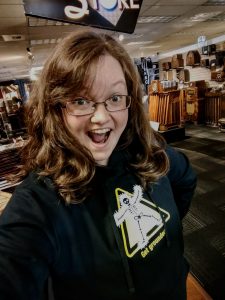Feedback from teachers who bring their students to SPARK Museum of Electrical Invention consistently results in two main observations:
- SPARK is wonderful at helping students translate book knowledge to real-world experiences.
- SPARK is an underutilized resource in the Bellingham community, and more teachers should take advantage of it.
“The hands-on nature of this field trip appealed to children’s natural desire to hold, touch, and explore through their senses,” one teacher told us recently. “The historical information was great, giving us a perspective on the human penchant for experimentation and invention.”
Abby Russell, the director of programs here at SPARK, has heard this sentiment from many teachers, and she’s pleased to see that the word has been spreading in the Bellingham and Whatcom County education community about SPARK’s value as an educational resource.
SPARK puts science and history into action
“What teachers seem to appreciate most about SPARK,” Russell says, “is the depth to which we go and the way we are able to put science and history into action. Teaching about protons and electrons is important and necessary, and then students come to SPARK is to see what they have learned put to the test in the real world. Everything comes alive and begins to make sense in a bigger context.”
Being able to see the principles of electricity in action — and to observe how great thinkers of the past have turned the theoretical into the practical — helps inspire and ignite curiosity in new ways, she says.

“We are not here to replace science education in the classroom,” says Abby Russell, SPARK’s director of programs. “We have the great honor of being able to assist teachers in inspiring their students and showing them that what it takes to be a scientist is curiosity, creativity and the willingness to be wrong and to try again.”
“We are not here to replace science education in the classroom,” she says. “We have the great honor of being able to assist teachers in inspiring their students and showing them that what it takes to be a scientist is curiosity, creativity and the willingness to be wrong and to try again.”
One of the key features of SPARK is that the museum approaches science through an interdisciplinary lens – a viewpoint that not only helps students understand science but that also uses science to inform other disciplines. At SPARK, we use stories to teach science, and we use science to teach critical thinking. We look at science historically to make it relevant to the present. We use art to show the creativity in scientific discovery. And on and on.
Science doesn’t always have to be the goal; sometimes it’s the mechanism to a bigger lesson.
How does this approach help teachers?
“When you take a field trip to SPARK, you learn science,” Russell says. “But you also get a sense that science is everywhere, with endless ways to approach it and the world around you. As a teacher, when you come to SPARK, what we model is an approach to science that helps make science accessible for all, because we have found entry points into science from every other subject.”
SPARK is a resource for teachers who might be looking for fresh ways to access science through other subjects, and the other way around.
“When students arrive at SPARK who aren’t naturally interested in science, we work to introduce the topic through other subjects they might be interested in,” Russell says. “Even just the ‘wow’ factor of the MegaZapper can be the changing point for a student. And that’s something hard to replicate in the classroom.”
That opportunity for real-world experience — getting students in front of the actual devices that have changed the course of human history, out of the classroom and into the minds of some of our world’s greatest and most ingenious thinkers — makes SPARK an indispensable resource for students from kindergarten through 12th grade and on through college.
After a recent visit, one local high school teacher told us about the value of SPARK no just for elementary students, but for all: “I’m now a believer that SPARK should be part of more high school science programs. It is a real treasure in our community.”
What’s next?
Russell is in the midst of building a comprehensive set of classroom resources — lesson plans, classroom activities and more — for teachers to use in teaching subjects like static electricity, energy, sound, electromagnetism and history. She hopes that will be ready by mid-summer, in time for teachers throughout Whatcom County to use them in the upcoming school year.
SPARK Museum also will continue to play host to field trips and to teacher-focused soirees – like the recent Teacher Appreciation Event – in an effort to introduce more Whatcom and Skagit educators to SPARK and the wonders it holds for teaching science in our community.
